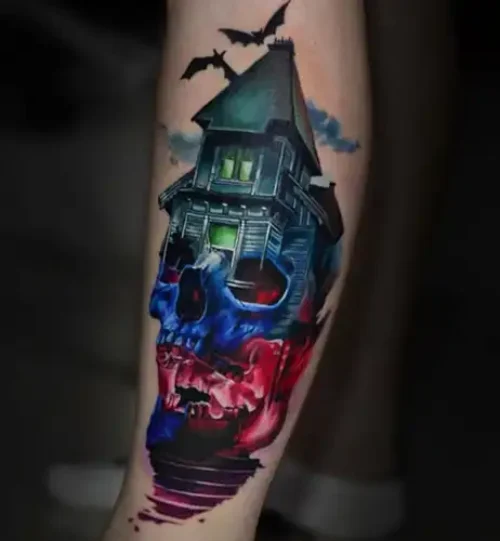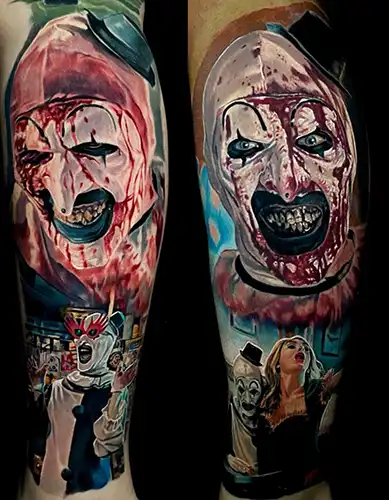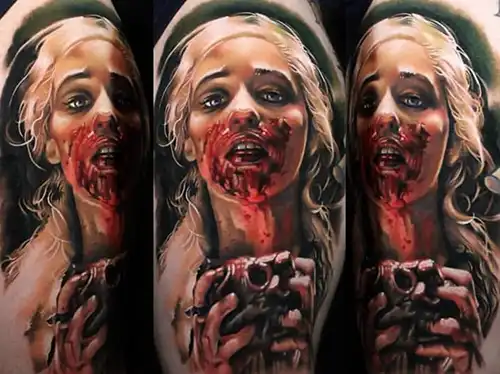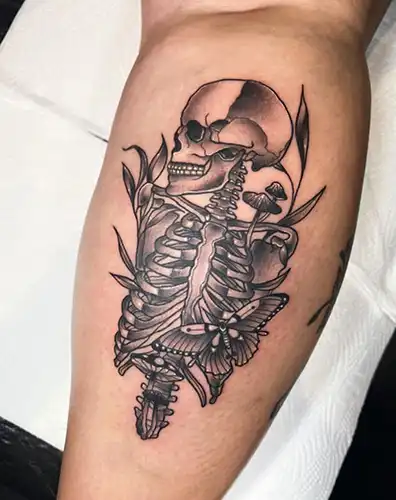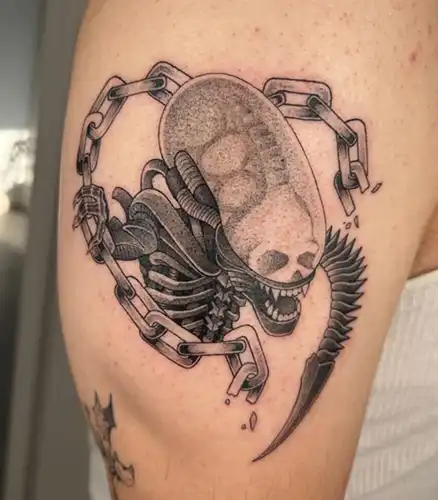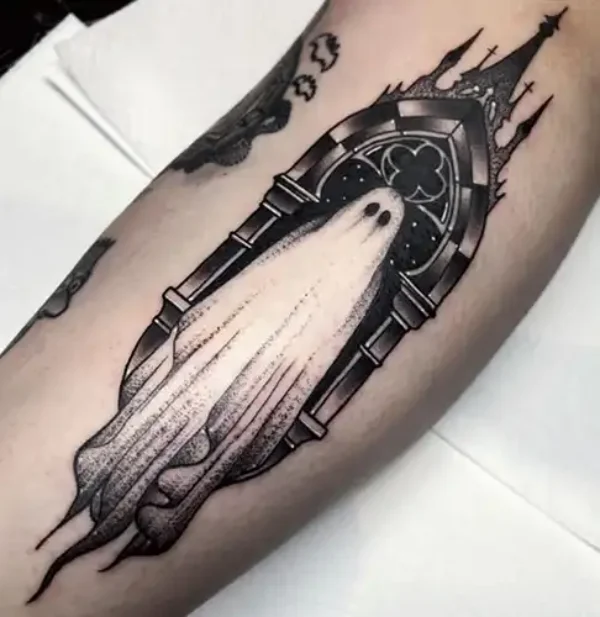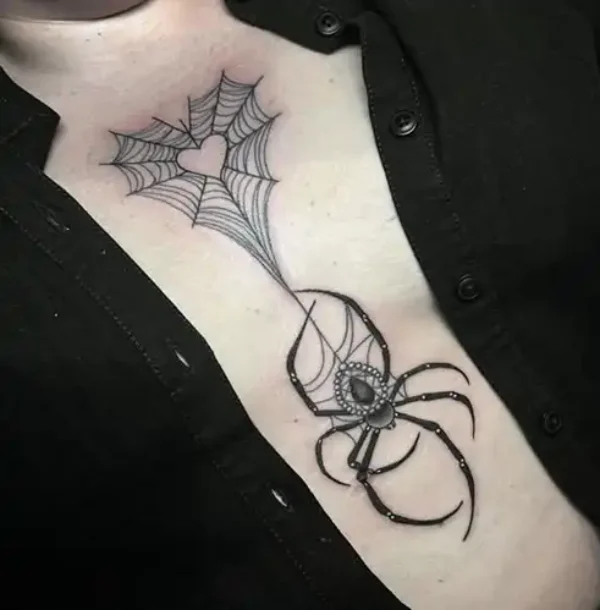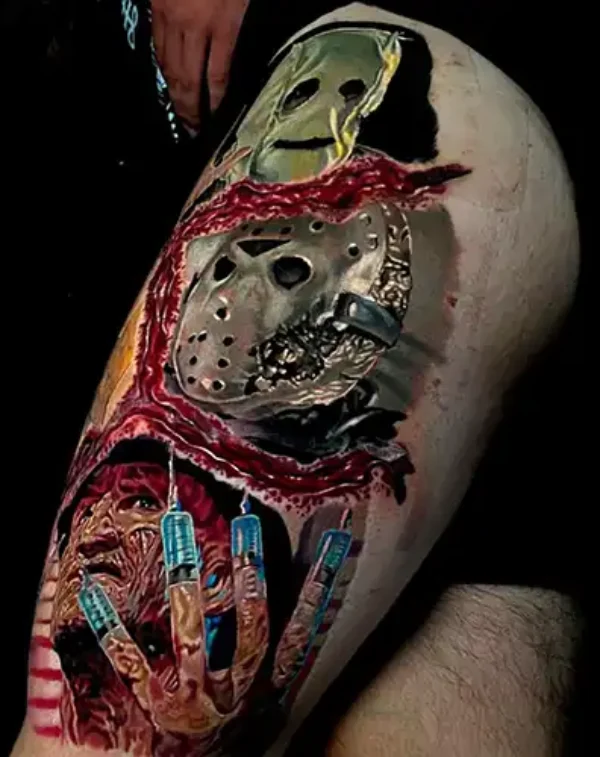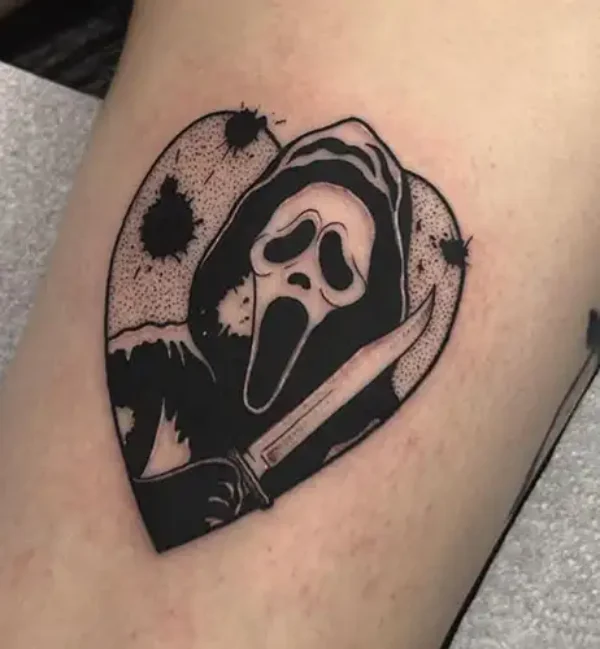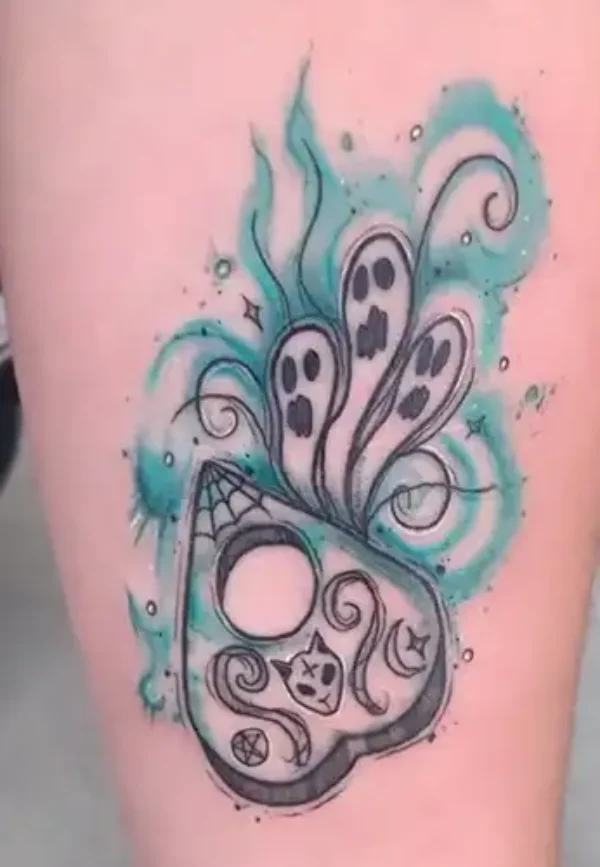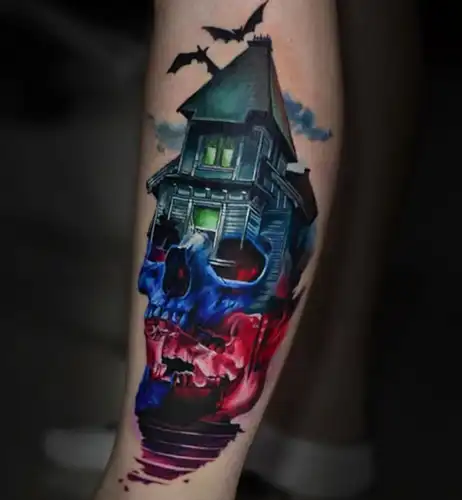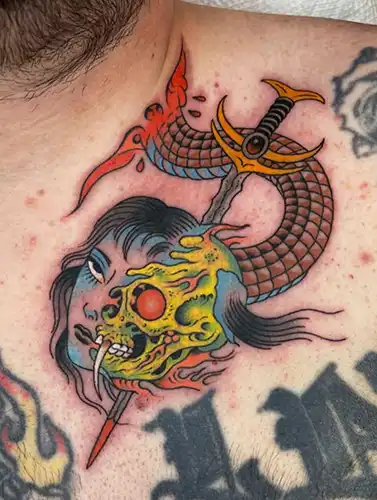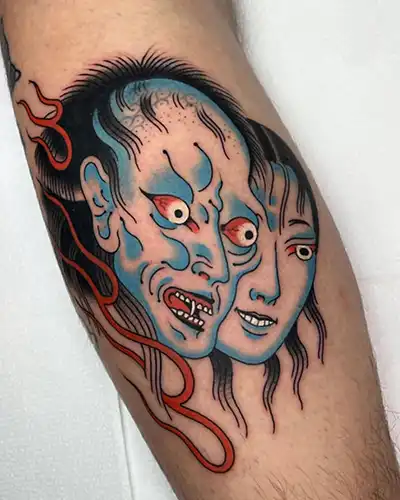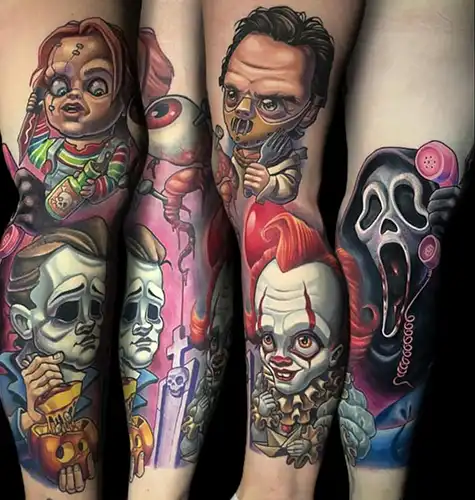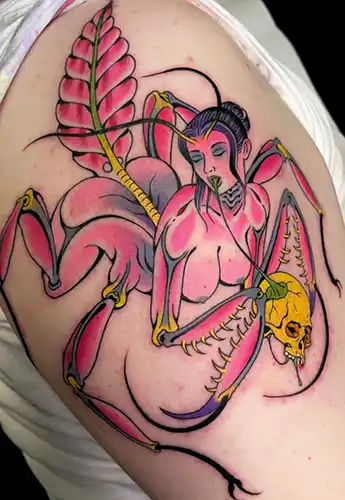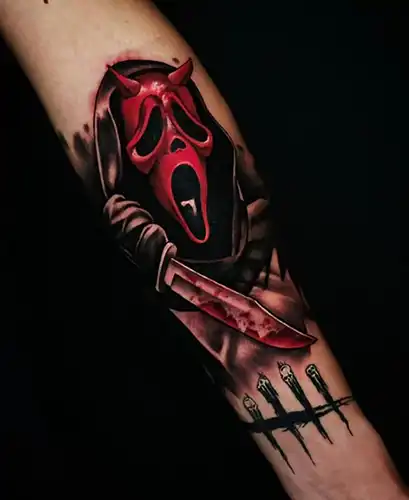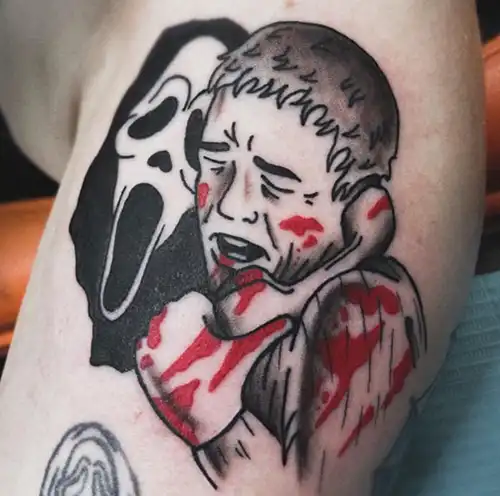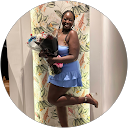Horror Tattoos in Nairobi, Kenya
Horror tattoos are an exciting and bold genre of body art that often appeal to fans of the macabre, dark aesthetics, or classic horror themes. These tattoos can range from detailed portraits of iconic horror movie characters to abstract, gothic designs, and even original creations inspired by the eerie and unsettling. They are typically known for their striking contrasts, bold use of blacks and reds, and intricate shading to bring out depth and realism.
Horror Tattoos
Some common horror tattoo themes include:
- Classic Horror Movie Characters: Icons like Freddy Krueger, Jason Voorhees, Michael Myers, or Pennywise the Clown are often immortalized in detailed portrait tattoos.
- Skulls and Skeletons: These are timeless symbols in horror art, often depicted in highly stylized or realistic ways.
- Zombies and Ghouls: Walking dead themes are popular, with varying levels of decay and grotesque detail.
- Monsters and Creatures: Vampires, werewolves, Frankenstein’s monster, and other supernatural creatures are frequently requested in horror tattoos.
Dark Forests, Haunted Houses, and Graveyards: Settings that evoke fear and mystery are often used as backdrops for larger tattoo pieces.
The key features of Horror Tattoos include:
The key features of horror tattoos that make them distinct and appealing to fans of the genre include:
- Dark and Intense Imagery
– Bold Black and Gray Work: These tattoos often rely heavily on black and gray shading to create depth, shadows, and a foreboding atmosphere.
– Contrasting Colors: Red, blood splatters, eerie greens, or deep purples are used to add drama and intensity.
– Realistic Gore: Depictions of blood, wounds, and body horror are common, emphasizing the gruesome aspects of the horror genre. - Iconic Characters and Themes
– Horror Movie Icons: Characters from horror films like Freddy Krueger, Jason, Michael Myers, or Chucky are frequently requested, showcasing love for classic horror.
– Monsters and Creatures: Vampires, werewolves, zombies, demons, and ghouls are staples in horror tattoos.
– Eerie Symbols: Skulls, skeletons, coffins, bats, haunted houses, and graveyards are common motifs. - Realism and Detail
– Hyper-Realism: Many horror tattoos use extreme realism to give a lifelike quality to the terrifying images, from decaying flesh to monstrous figures.
– Intricate Linework: The detail in horror tattoos can be incredibly intricate, bringing a sense of depth and texture to the designs.
– Portraiture: Realistic portraits, especially of famous horror characters or eerie faces, are popular. - Atmospheric Settings
– Dark Backgrounds: Fog, mist, dark forests, abandoned houses, and night skies often set the stage for horror tattoos.
– Creepy Elements: Images like cracked mirrors, chains, barbed wire, and crows are often incorporated to enhance the eerie vibe. - Macabre and Gothic Aesthetics
– Skulls and Bones: Often featured in a stylized way to give a morbid or gothic feel.
– Victorian Gothic Influence: Some designs may incorporate gothic elements like gargoyles, Victorian-style dresses, and architecture to evoke a dark, haunted atmosphere. - Symbolism and Psychological Horror
– Psychological Themes: Tattoos that play on fear, paranoia, or unsettling emotions. For example, depicting eyes, dark corridors, or twisted figures to symbolize inner fears.
– Nightmare and Dreamscape: Surreal, distorted, and dream-like elements are used to create an unsettling or haunting feeling. - Use of Negative Space
– Shadow Play: Negative space is often employed to create the illusion of shadows or to give the tattoo more depth, making the horror elements stand out even more.
Horror Tattoos Design Style Techniques
Horror tattoos require unique design style techniques to achieve their dark, atmospheric, and eerie qualities. Here are the common techniques used by tattoo artists to create striking horror tattoos:
Realism (Hyper-Realism)
Detailed Shading: Realistic shading is key in horror tattoos, especially for creating depth in faces, monsters, or scenes. This style allows the artist to bring lifelike qualities to horror icons, making them more terrifying.
Texture Replication: Using fine needles and gradient shading to replicate the textures of decaying flesh, skulls, or hair to make the imagery feel tangible.
Photorealism: Tattoos of horror characters, like Freddy Krueger or Pennywise, often use this style to look like exact replicas of their film counterparts.
Black and Gray Work
Monochrome Focus: Horror tattoos often use only black and gray, adding drama and mood. This allows for a stronger focus on contrast, light, and shadow to create a menacing look.
Soft and Smooth Gradients: Smooth transitions between light and dark shades add depth and create the illusion of 3D, making skulls, ghosts, or creatures pop out from the skin.
Chiaroscuro (High Contrast)
Strong Light and Shadow Contrast: Inspired by the chiaroscuro technique in fine art, this involves placing extreme darks against lights to highlight features like hollow eyes or ominous shadows.
Highlighting Key Elements: Bright white highlights may be used to emphasize a glint of light on a blade, teeth, or eerie eyes, creating a strong focus point within the design.
Dotwork and Stippling
Subtle Shading: For tattoos that require a softer, eerie effect, stippling (a series of dots) is used to create gradients, such as misty backgrounds or decaying textures. It provides a softer feel than heavy black shading but still adds a creepy element.
Textural Enhancement: Dotwork can also be used to add a unique texture to skulls, bones, or decayed surfaces, giving the tattoo an organic and unsettling feel.
Line Work and Etching
Thin, Crisp Lines: Fine line work can create intricate, delicate details in horror designs like spider webs, fine cracks, or skeletal fingers.
Scratchy or Etched Lines: This technique mimics hand-drawn, sketch-like textures, which can make tattoos look like they were etched or scratched onto the skin, enhancing a raw, disturbing look.
Biomechanical/Anatomical Design
Blending Horror with Anatomy: This style integrates horror elements into the human anatomy, for example, exposing veins, muscles, and bones in a decayed or gory fashion.
Mechanical Horror: Combining organic forms (bones, flesh) with mechanical elements (gears, wires) to create unsettling biomechanical tattoos that seem half-human, half-machine.
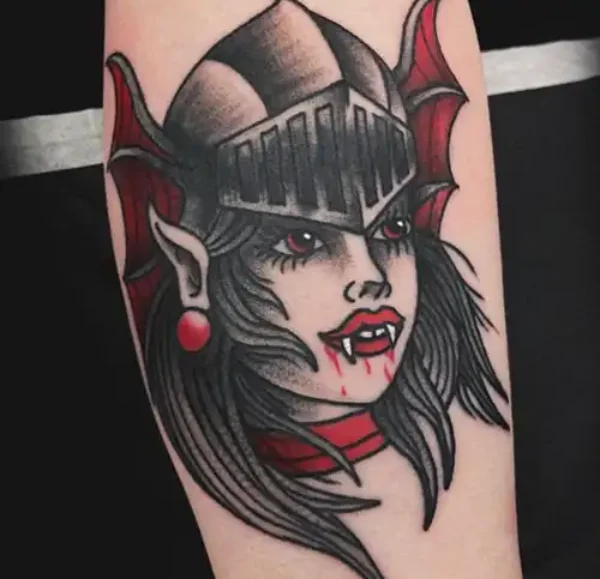


Illustrative Style
Cartoonish or Surreal Elements: Some horror tattoos use bold, comic-style outlines with exaggerated features, especially for classic monster designs, for a more playful take on horror.
Stylized Proportions: Faces, limbs, or features may be exaggerated, distorted, or stretched to evoke a sense of unease or nightmare-like qualities.
Negative Space Usage
Dark Silhouettes: Horror tattoos often use black-filled areas to create stark silhouettes of objects like bats, graveyards, or haunted trees. Negative space within the blackness adds contrast and allows lighter elements, such as eyes or skulls, to emerge.
Creating Depth: Clever use of negative space gives tattoos a layered, multidimensional look. Shadows or distant backgrounds, such as dark forests or fog, are created this way.
Watercolor Horror
Splashes of Color: Though most horror tattoos are done in black and gray, some use watercolor techniques to create chaotic, blood-splattered effects or eerie color washes, like ghostly greens or burning reds.
Smoky, Dripping Effects: Watercolor styles can also mimic fog, mist, or dripping blood, adding fluidity and an ethereal quality to the design.
Surrealism
Distortion of Reality: Horror tattoos often take elements of surrealism, such as melting faces, twisted limbs, or disjointed figures, to amplify the sense of horror. These surreal designs evoke dream-like or nightmarish visuals.
Dreamscapes and Nightmares: By blending normal imagery with eerie and unnatural elements, this style creates tattoos that feel unsettling, like scenes pulled from a nightmare.
New School Horror
Vibrant Colors: A modern twist on horror tattoos, this style uses bold, vibrant colors with exaggerated, cartoonish features. Think neon greens, purples, and reds for exaggerated blood, slime, or gore effects.
Oversized Features: Large, exaggerated eyes, sharp teeth, and grotesque proportions are hallmarks of new school horror tattoos, offering a playful yet disturbing twist on traditional horror themes.
Trash Polka
Graphic Elements: This style blends photorealism with abstract shapes, smudges, and splashes of red or black ink. It creates a chaotic, rebellious look that fits well with dark horror themes.
Contrast of Order and Chaos: The combination of photorealistic horror images, like skulls or faces, with abstract brush strokes or text creates a bold and unique visual effect.
These techniques, when combined, allow for a broad range of artistic expression within horror tattoos, enabling artists to create deeply personalized and impactful designs that resonate with the wearer’s dark or eerie aesthetic preferences.
Schedule Appointment
Horror Tattoos FAQs
Horror Tattoos Process
The process of getting a horror tattoo is similar to other tattoo styles but involves specific steps to ensure the eerie details and atmosphere come through effectively. Here’s a breakdown of the key stages:
- Consultation and Concept Development
– Discuss Ideas with our Artist: The process begins with a consultation between our client and our tattoo artist. Our client shares their vision, including any specific horror themes, characters, or elements they want.
– Research and Reference Gathering: Our artist will gather references, whether it’s iconic horror characters or custom elements like skulls, zombies, or haunted scenes.
– Style and Technique Decisions: Our artist will suggest design styles (e.g., realism, illustrative, black and gray) based on our client’s ideas. They’ll also decide on the shading technique, use of color (if any), and placement of the tattoo.
– Sketching the Design: Our artist will create a rough sketch or digital rendering of the horror tattoo design. This may go through a few revisions based on client feedback. - Design Finalization
– Detailed Drawing: Once the concept is approved, our artist refines the sketch into a more detailed final design, ensuring that all the horror elements (like shadows, textures, and details in the face or scene) are clear.
– Placement and Size: Our artist will determine the best size and placement on the body to ensure that the fine details (such as decayed skin or intricate backgrounds) can be executed properly.
– Stencil Creation: The final design is made into a stencil, which will be transferred to our client’s skin for accurate application. - Preparation
– Pre-Tattoo Instructions: Before the session, our client may be given specific instructions such as staying hydrated, getting plenty of rest, and avoiding alcohol, which can thin the blood.
– Skin Preparation: Our tattoo artist cleans and shaves the area where the tattoo will be placed, ensuring the skin is smooth and free of any oils or dirt.
– Stencil Application: The stencil is applied to the skin and adjusted for exact placement. Our client can see how the tattoo will sit on their body and approve the positioning. - Tattooing Process
– Linework First: Our tattoo artist begins with the outlines. For horror tattoos, this may involve fine line work or bold lines, depending on the style (e.g., realism or illustrative).
– Shading and Texture: Once the outlines are complete, our artist will begin shading. Horror tattoos often rely heavily on shading to create depth, dimension, and mood, especially in areas like skulls, monsters, or dark backgrounds. Techniques like stippling or smooth gradient shading may be used.
– Color Application (Optional): If the design includes color, our artist will carefully add these elements next. Horror tattoos may include red for blood, eerie greens, or deep purples for otherworldly effects.
– Details and Highlights: The final touches are often what bring horror tattoos to life. Intricate details, such as scars, blood splatters, or fine textures (like decaying skin or wrinkles), are added. White ink may be used to add highlights, making certain features like eyes or blades pop. - Pain Management
– Adjusting to the Pain: Horror tattoos, especially those with a lot of intricate shading or large areas, can be time-consuming and painful, depending on placement. Clients are encouraged to take breaks when needed.
– Numbing Cream (Optional): Some of our clients may opt for numbing creams to alleviate the pain, but it’s important to consult our tattoo artist about using it beforehand. - Post-Tattoo Care Instructions
– Initial Care: Once the tattoo is complete, our artist will clean the area and apply a protective layer (like a plastic wrap or bandage) to prevent infection.
– Aftercare Instructions: Clients are given detailed aftercare instructions to ensure proper healing. This includes keeping the tattoo clean, avoiding sun exposure, moisturizing the area with recommended products, and not picking at any scabs that form.
– Healing Process: Horror tattoos, especially detailed or large ones, may take longer to heal due to the extensive shading and linework. Full healing typically takes 2–4 weeks. - Touch-Ups and Finalizing
– Possible Touch-Ups: Depending on the healing process, our client may need to return for a touch-up session. Horror tattoos, with their intense shading and fine details, sometimes require small adjustments to ensure the ink heals evenly.
– Final Look: Once fully healed, the tattoo will reveal its final appearance. Horror tattoos are designed to be visually impactful, and elements like shading, contrast, and highlights will become more prominent after healing. - Long-Term Care
– Moisturizing and Maintenance: Like all tattoos, horror tattoos need regular care to maintain their vibrancy. Keeping the skin moisturized and applying sunscreen when exposed to the sun can help preserve the details and prevent fading.
– Periodic Check-Ins: Some horror tattoos, especially those with heavy black shading or delicate lines, may require touch-ups over the years to keep them looking sharp and intense.
The process of getting a horror tattoo involves careful planning and attention to detail. From choosing the design and style to executing intricate shading and maintaining proper aftercare, each step ensures that the tattoo brings horror art to life in a hauntingly beautiful way.
Horror Tattoos Customization and Personalization
Customization and personalization are key elements in horror tattoos, allowing clients to create deeply personal designs that resonate with their unique tastes in horror, while showcasing the tattoo artist’s creativity. Here’s how horror tattoos can be customized and personalized:
- Incorporating Personal Fears or Phobias
– Unique Psychological Horror: Rather than focusing on common horror icons, some tattoos can be based on personal fears like spiders, darkness, drowning, or claustrophobia. These designs turn specific fears into haunting visuals that are deeply personal to the wearer.
– Symbolic Representation: Artists can take abstract concepts, such as anxiety or trauma, and represent them through eerie and surreal elements like eyes watching from the shadows, disjointed figures, or nightmarish dreamscapes. - Combining Horror Themes with Personal Elements
– Blending Horror with Personal Stories: Tattoos can incorporate horror aesthetics with symbols of personal meaning. For instance, a loved one’s name or birthdate could be integrated into a gothic graveyard scene, or personal items (like a necklace or pocket watch) could be part of a haunted or cursed design.
– Family or Friends as Characters: Some clients choose to portray family members or friends in a horror setting, transforming them into zombies, vampires, or ghoulish figures for a fun and deeply personalized twist on classic portrait tattoos. - Custom Characters or Monsters
– Original Monster Design: Rather than sticking to well-known horror characters, a custom-designed creature or monster can be created to reflect the wearer’s imagination. Our tattoo artist can collaborate with our client to create a unique monster that embodies their vision of horror.
– Combining Features from Different Monsters: If our client is a fan of multiple creatures (like vampires, werewolves, and zombies), the artist can combine features to create a hybrid monster unique to the individual. - Mixing Horror Genres
– Classic Horror and Modern Influences: Custom horror tattoos can mix different genres, like combining classic horror with modern sci-fi elements. For example, a werewolf with cybernetic limbs or a ghost haunting a futuristic spaceship could blend themes and genres to create a personalized horror style.
– Cross-Cultural Horror: Horror from different cultures can be blended to create unique designs. Elements from Japanese horror (like the yurei or onryo spirits) can be combined with Western gothic themes, creating a one-of-a-kind piece. - Personalizing Iconic Characters
– Unique Depictions of Famous Characters: Even if our client wants a well-known horror character, the tattoo can be customized to reflect their personal style.
– Hybrid or Mashup Tattoos: Two or more iconic characters can be combined into one design. For instance, a hybrid tattoo of Freddy Krueger and Jason Voorhees or a mashup of Dracula and Frankenstein can create a unique spin on classic horror characters. - Custom Horror Portraits
– Horror Portraits with a Twist: Some clients may want a loved one or even themselves depicted in a horror setting. The portrait could be customized to show the person as a vampire, zombie, or ghost. This can be done in either a realistic style or a more exaggerated, comic-book style.
– Unique Backgrounds and Settings: The background of a portrait tattoo can be customized with personal or thematic elements. For instance, a loved one’s portrait could be set in a haunted forest, surrounded by supernatural elements like bats, ghosts, or skulls. - Incorporating Symbolism and Meaning
– Hidden Meanings: Horror tattoos can include symbolic elements that hold personal meaning. For example, a skull might represent the concept of mortality, while a raven could symbolize death or transformation, and a broken clock could represent lost time.
– Blending Horror with Positive Symbols: Our client can balance dark horror elements with symbols of hope or strength. A design may include a decaying rose to symbolize beauty in decay, or a broken chain to represent overcoming fear. - Unique Color Palettes
– Alternative Color Schemes: While black and gray are common in horror tattoos, clients can choose to add personalized color schemes. Bright neon colors for blood, eerie greens, or pastels for a ghostly appearance could set their tattoo apart from traditional designs.
– Monochrome with Personal Accents: Even in black and gray designs, a touch of personalized color, such as red for blood or a glowing green for supernatural elements, can add a unique flair to the horror tattoo. - Custom Horror Scenes
– Narrative-Based Tattoos: A client may want to depict a horror scene that tells a story, either based on personal imagination or inspired by their favorite horror tales. This could include a haunted house they dream of or a battle between monsters and humans.
– Unique Locations: Custom horror tattoos can be based on real-life locations that have personal significance. For instance, a favorite childhood home could be reimagined as a haunted house, or a forest where important memories were made could be transformed into a dark, eerie setting. - Tattoo Placement Personalization
– Strategic Placement for Horror Effect: Certain tattoo placements can enhance the horror effect. For example, a skull tattoo over the chest can give the illusion of skeletal exposure, or a horror face on the calf can create a surprising effect when revealed.
– Integration with Body Features: Horror tattoos can be designed to interact with the body’s natural contours. For example, a tattoo of a creature’s eyes might be placed on the back of the neck for a spine-chilling effect, or a mouth might be tattooed on the hand so it looks like it’s biting when the hand moves. - Collaborative Process
– Client Input on Every Detail: Artists can work closely with clients, allowing them to provide input on even the smallest details—whether it’s the specific shading, style of blood splatter, or the positioning of eerie elements.
– Sketch Adjustments: After the initial design, clients can request adjustments to make the tattoo feel more personal. These adjustments could involve adding more symbols, changing the mood, or tweaking facial expressions. - Cultural or Mythological Elements
– Incorporating Personal Heritage: Horror tattoos can also reflect a client’s cultural or mythological background. A client might choose to incorporate creatures from their cultural folklore, such as the Slavic Baba Yaga, Japanese Yokai, or Mexican La Llorona.
– Spiritual Symbols with a Dark Twist: Horror tattoos can incorporate traditional spiritual symbols but with a dark or macabre twist. For instance, angel wings might be depicted as torn or decayed, or a traditional religious figure could be reinterpreted with eerie or horror-infused details. - Personal Quotes or Text
– Meaningful Words in a Horror Setting: Personal quotes, names, or text can be integrated into horror designs, written in blood-drip fonts or engraved onto tombstones within the tattoo.
– Handwritten Elements: A client’s own handwriting, or that of a loved one, could be incorporated into the design, giving the tattoo an intimate, haunting personal touch.
Through these methods, horror tattoos become not only a striking form of dark art but also a deeply personal reflection of the wearer’s tastes, fears, and imagination. This makes each horror tattoo unique and meaningful.
Horror Tattoos Longevity and Aftercare
Horror tattoos, known for their intricate details, dark shading, and high-contrast designs, require proper aftercare and maintenance to preserve their longevity. The distinct features like heavy black areas, detailed shading, and delicate highlights are prone to fading if not cared for properly. Here’s how to ensure a horror tattoo maintains its eerie appeal over time:
- Initial Aftercare: Ensuring a Good Start
– Protective Covering: Immediately after the tattoo is finished, our artist will apply a protective bandage or plastic wrap to prevent bacteria from entering the open skin. This covering should be kept on for the time recommended by our artist (usually 2–24 hours).
– Cleansing the Tattoo: Once the bandage is removed, the tattoo should be gently washed with warm water and mild, fragrance-free soap. Avoid scrubbing or using hot water, which can irritate the skin and damage the tattoo.
– Moisturizing: After washing, pat the tattoo dry with a clean towel and apply a thin layer of a recommended moisturizer or tattoo aftercare ointment. This helps keep the skin hydrated and prevents it from drying out or cracking.
– Avoid Over-Moisturizing: Too much moisture can cause the tattoo to become soggy, which may lead to the ink breaking down prematurely. Apply thin layers of moisturizer as needed, allowing the skin to breathe. - Healing Process: The Crucial Phase
– Peeling and Scabbing: As the tattoo heals, it will begin to scab and peel. This is a natural part of the process. Do not pick at the scabs or peel the skin, as this can remove ink and cause uneven healing, particularly damaging to the fine details in horror tattoos.
– Itch Management: The tattoo will likely itch as it heals, but resist scratching. Scratching can pull ink out of the skin and cause uneven fading, especially in areas with intricate shading or small highlights.
– Continue Moisturizing: Throughout the healing process (typically 2–4 weeks), continue to keep the tattoo moisturized but avoid heavy creams or petroleum-based products that can clog pores. - Avoiding Sun Exposure
– UV Rays and Fading: Sun exposure is one of the biggest factors that can cause a tattoo to fade, especially for horror tattoos with extensive black shading and fine details. UV rays break down the ink, leading to dullness over time.
– Use Sunscreen: After the tattoo has fully healed, always apply a broad-spectrum sunscreen (SPF 30 or higher) when the tattoo is exposed to sunlight. Reapply sunscreen regularly to prevent damage and fading.
– Covering the Tattoo: In addition to sunscreen, covering the tattoo with clothing or avoiding direct sunlight for prolonged periods will further protect it from fading. - Long-Term Moisturizing
– Keeping the Skin Hydrated: Even after the healing process is complete, keeping the skin moisturized helps maintain the brightness of the ink and keeps the skin healthy. Dry skin can cause a tattoo to look dull and the lines to appear less sharp.
– Use Gentle Products: Stick to fragrance-free, alcohol-free moisturizers to avoid irritation or dryness, which could affect the tattoo’s appearance over time. - Avoiding Harsh Environments
– Chlorine and Salt Water: Swimming pools and the ocean contain chemicals and salts that can cause fading and irritation during healing and even after the tattoo is fully healed. Avoid prolonged exposure, especially during the first few weeks.
– Hot Tubs and Saunas: Excessive heat and moisture can cause a fresh tattoo to overheat or swell, potentially damaging the ink and leading to blurred lines or patchy shading. - Touch-Up Sessions
– Natural Fading Over Time: Even with the best care, tattoos will naturally fade over time, especially darker horror tattoos with heavy shading or black backgrounds. Fine lines and white highlights are particularly prone to fading.
– Touch-Ups to Revive the Design: Periodic touch-up sessions can restore the vibrancy of the tattoo and fix any areas where the ink has faded or settled unevenly. Horror tattoos with detailed shading or negative space designs may need more frequent touch-ups to keep their sharpness.
– Check with our Artist: At Rebel Inks Tattoos, Tattoo Removal, and Body Piercings Parlour we offer discounted touch-up session within the first year to address any areas that healed imperfectly. - Maintaining Fine Details
– Regular Inspection: Inspect the tattoo regularly, especially if it has intricate details like fine lines, small highlights, or delicate textures. These elements tend to fade or blur faster and may need more care or touch-ups to maintain clarity.
– Protecting White Ink and Highlights: White ink and light highlights used in horror tattoos (for eerie eyes, teeth, or glares) tend to fade more quickly than other colors, as they are less saturated. Extra care with sun protection and moisturizing is essential to keep these areas looking fresh. - Diet and Hydration
– Skin Health: Keeping your body and skin healthy also helps with tattoo longevity. Drink plenty of water, eat a balanced diet, and maintain a skincare routine to ensure your skin stays hydrated and supple.
– Healthy Skin, Vibrant Tattoo: Well-hydrated skin will keep the tattoo looking vibrant and prevent cracking or fading in the ink over time. Dry or unhealthy skin can cause the tattoo to lose its sharpness and clarity. - Avoiding Skin Trauma
– Avoid Scratches and Burns: Any trauma to the tattooed skin, such as cuts, burns, or scrapes, can permanently damage the ink and cause patchy fading. Take extra care to protect the tattooed area from injuries.
– Exfoliating Gently: If you exfoliate your skin, be gentle around the tattoo. Harsh scrubbing can wear down the top layers of skin and cause the ink to fade prematurely. - Consider Placement Impact
– High-Friction Areas: Tattoos on areas that experience frequent rubbing or friction (like hands, feet, or inner thighs) may fade faster than those in more protected spots. Horror tattoos on these areas may require more frequent touch-ups to maintain detail.
– Movement and Flexibility: Areas of the body that move or stretch a lot (e.g., elbows, knees) can cause tattoos to blur or lose shape over time. Keeping the skin moisturized and in good condition can minimize these effects. - Quality of Ink and Artist Technique
– Ink Longevity: High-quality tattoo ink tends to last longer and fade less quickly, so it’s important to choose an experienced artist who uses premium inks, especially for horror tattoos with high-contrast shading.
– Artist’s Technique: The skill of the tattoo artist also affects longevity. Horror tattoos with fine details and complex shading require precision. A good artist will know how to apply the ink to ensure it stays vibrant and crisp for as long as possible. - Tattoo Aging: Embracing the Patina
– Natural Aging: All tattoos change with time. As the tattoo ages, some elements may soften or blur slightly. While some fading is inevitable, embracing the aging process can add a vintage, eerie patina to horror tattoos, enhancing their spooky atmosphere.
– Maintaining Dark and Bold Areas: Keeping dark sections bold and crisp will ensure the tattoo retains its haunting impact, even as it ages.
By following these aftercare and long-term maintenance guidelines, horror tattoos can stay vivid, detailed, and striking for many years, allowing their haunting beauty to stand the test of time.
Factors that you should consider when getting Horror Tattoos
When getting a horror tattoo, there are several important factors to consider to ensure you get the best possible outcome. Horror tattoos are often intricate, with heavy shading and dramatic imagery, so proper planning is essential. Here are the key factors to keep in mind:
- Choosing the Right Artist
– Experience in Horror Tattoos: Not all tattoo artists specialize in horror-themed designs. Look for an artist with a portfolio showcasing their skill in creating eerie, dark, and horror-inspired tattoos. They should have a strong grasp of realism, black-and-gray work, and shading techniques.
– Artistic Style Compatibility: Some artists may be better at certain styles, such as realistic portraits, abstract horror, or illustrative designs. Make sure the artist’s style matches your vision for the tattoo.
– Reputation and Reviews: Research the artist’s reputation by reading reviews, checking their social media, and asking for recommendations. An experienced and well-reviewed artist is more likely to produce a high-quality tattoo. - Design and Customization
– Originality vs. Classic Horror: Decide whether you want a tattoo based on classic horror icons or a custom, original design. Original designs are unique and personal, but some clients prefer recognizable characters or scenes from their favorite horror movies.
– Personal Elements: Consider incorporating personal elements, such as fears, phobias, or symbolic items, to make the tattoo more meaningful. Blending personal symbolism with horror can result in a tattoo that is both haunting and significant to you.
– Placement and Size: Horror tattoos often involve intricate details and shading, which require enough space to be properly executed. Larger tattoos allow for more depth and complexity. Choose a location on your body that provides ample space for the design without sacrificing clarity. - Tattoo Style and Technique
– Black and Gray vs. Color: Horror tattoos are commonly done in black and gray to enhance the eerie and dark atmosphere, but color can also be used for blood, gory effects, or supernatural elements. Consider whether you want a monochromatic design or a mix of colors.
– Realism vs. Illustrative: Horror tattoos can range from realistic portrayals of monsters and scenes to more illustrative, cartoonish, or abstract designs. Realistic tattoos often have a more disturbing, lifelike quality, while illustrative designs may be more stylized and imaginative.
– Detail and Shading: Consider how much detail you want in the design. Horror tattoos often involve intricate shading to create depth, shadows, and texture, but too much detail in a small area can blur over time. Work with your artist to strike a balance between detail and readability. - Tattoo Placement
– Visibility: Think about how visible you want your horror tattoo to be. Some people prefer to keep their horror-themed tattoos in less visible areas like the back, chest, or thighs, while others enjoy showcasing them on their arms or neck.
– Body Contours: Consider how the tattoo will interact with the shape and movement of your body. Certain designs, like skulls or faces, may require flat areas to maintain their proportions and clarity. Discuss with your artist how the design will flow with your body’s natural contours.
– Skin Sensitivity: Some areas of the body, like the ribs, hands, or feet, are more sensitive and can make the tattoo process more painful. Make sure you’re prepared for the level of discomfort based on the placement. - Pain Tolerance
– Tattoo Placement and Pain: Horror tattoos, especially larger pieces, can require multiple sessions and may be more painful depending on placement. Areas with thinner skin or more nerve endings, such as the ribs, spine, or neck, tend to be more painful.
– Session Duration: Horror tattoos with a lot of detail and shading can take many hours to complete, sometimes over multiple sessions. Be prepared for the time commitment and the physical toll of sitting for long tattoo sessions. - Budget
– Cost of the Tattoo: Horror tattoos, especially detailed or large-scale ones, can be expensive due to the time, expertise, and precision required. Make sure you have a budget that reflects the complexity and size of the tattoo you want.
– Touch-Up Costs: Detailed tattoos may require occasional touch-ups to maintain their clarity and vibrancy. Consider the potential future costs of maintaining the tattoo over time. - Longevity and Maintenance
– Fading Over Time: Tattoos, especially those with fine details or heavy black shading, may fade over time. Choose an artist who uses high-quality ink and has experience with long-lasting designs. Regular touch-ups may be necessary to keep the tattoo looking fresh.
– Skin Care: Proper aftercare is critical to maintaining the longevity of a horror tattoo. Follow your artist’s aftercare instructions closely, moisturize regularly, and protect your tattoo from sun exposure with sunscreen to prevent premature fading. - Lifestyle Considerations
– Professional Environment: Depending on your profession, visible horror tattoos may not be acceptable in all workplaces. If you need to maintain a certain level of professionalism, consider getting the tattoo in a place that can be easily covered.
– Future Skin Changes: Keep in mind that your skin will change over time due to aging, weight gain, or loss, which can affect the appearance of the tattoo. Certain areas of the body, such as the stomach or upper arms, may be more prone to stretching or distortion. - Tattoo Aftercare Commitment
– Post-Tattoo Care: Horror tattoos often involve extensive shading and intricate details, which require careful aftercare to heal properly. This includes cleaning, moisturizing, and avoiding sun exposure or swimming for a set period of time.
– Healing Time: Depending on the size and placement, the healing time for horror tattoos can vary. Larger pieces or those with heavy shading may take longer to heal fully. Be prepared for several weeks of aftercare. - Personal Comfort with the Theme
– Living with a Horror Tattoo: Horror tattoos often depict dark, gruesome, or disturbing imagery. Make sure you are comfortable with the idea of living with such imagery permanently on your body. Consider how it might affect your interactions with others, particularly in public or family settings.
– Emotional Connection: Many people choose horror tattoos because of their love for the genre or personal connections to certain horror themes. Ensure that the design is something you feel strongly connected to, as it will become a permanent part of your identity. - Tattoo Size and Complexity
– Size for Detail: The level of detail in horror tattoos often requires a larger canvas. Small tattoos may lose the impact of fine details like shading, texture, or facial expressions. Discuss with your artist the appropriate size to retain clarity over time.
– Session Planning: If the tattoo is particularly large or complex, it may require multiple sessions to complete. Be prepared for the time commitment, including healing time between sessions. - Tattoo Trends vs. Timeless Designs
– Staying Timeless: Horror tattoos that reflect timeless themes, such as gothic imagery, classic monsters, or symbolic representations of fear, are less likely to feel outdated over time. Avoid trends that might lose relevance or appeal in a few years.
– Cultural Sensitivity: Ensure the design does not unintentionally offend or misrepresent cultural or historical symbols. Horror tattoos can sometimes include symbols (such as skulls, crosses, or occult imagery) that may carry different meanings in different contexts.
Cost of Horror Tattoos in Nairobi, Kenya
The cost of horror tattoos can vary greatly depending on several factors, including the complexity of the design, the artist’s experience, the size of the tattoo, and the location of the tattoo studio. Here’s a breakdown of the factors that influence the cost of a horror tattoo:
- Tattoo Artist’s Experience and Reputation
– Renowned Artists: Well-known tattoo artists, especially those who specialize in horror tattoos, tend to charge more due to their experience and popularity. At Rebe Inks Tattoos, Tattoo Removal, and Body Piercings Parlour we have top-tier artists who may charge anywhere from Ksh. to Ksh.
– Specialization in Horror Tattoos: At Rebel Inks Tattoos, Tattoo Removal, and Body Piercings Parlour we have artists who specialize in horror themes, realism, or detailed black-and-gray work, because of the skill and precision required for these styles. - Size of the Tattoo
– Small Tattoos: For small horror tattoos (like a small skull, horror symbols, or minimalist horror designs), the cost typically ranges between Ksh. and Ksh.
– Medium-Sized Tattoos: Medium-sized horror tattoos that cover part of the arm, leg, or chest may cost between Ksh. and Ksh, depending on the detail and time required.
– Large Tattoos: Full horror-themed sleeves, large back pieces, or other intricate and detailed designs covering large parts of the body can cost Ksh. to Ksh. or more. These pieces often take multiple sessions to complete. - Color vs. Black and Gray
– Black and Gray Tattoos: Horror tattoos are often done in black and gray, which can be less expensive than colored tattoos because they use fewer inks and are generally quicker to complete. Black and gray horror tattoos may cost less per session compared to colored ones.
– Color Tattoos: If your horror tattoo involves color (like red for blood or eerie green hues for supernatural elements), the cost may increase due to the additional time required to blend colors and the cost of specialized inks. Color tattoos tend to require more frequent touch-ups as well, which adds to the long-term cost. - Tattoo Placement
– Easy-to-Tattoo Areas: Tattoos on areas like the arms, legs, or back are generally easier for our artist to work on and may be less expensive because the skin is less sensitive and the area is easier to access.
– Challenging Areas: Tattooing on more challenging areas like the ribs, hands, feet, or neck may cost more because these areas are more sensitive, require more time to tattoo, or involve more pain for the client, which can slow down the process. - Studio Location
– High-Demand Cities: In larger cities or areas with a high cost of living, tattoo studios typically charge more. In these areas, the rate may range from Ksh. to Ksh. Rebel Inks Tattoos, Tattoo Removal, and Body Piercings Parlour is located in the heart of the Central Business Disrict (CBD) in Nairobi, Kenya, and is easily accessible to both locals and foreigners in the country - Custom vs. Pre-Designed Tattoos
– Custom Designs: If you request a custom-designed horror tattoo, the cost will likely be higher than choosing a design from our artist’s portfolio. Custom work involves additional time for design, consultation, and adjustments, which can increase the overall price.
– Pre-Designed Tattoos: If you choose a pre-existing design from our artist’s flash collection, the cost may be lower since it requires less design work upfront. - Touch-Ups and Maintenance
– Initial Touch-Up Costs: Some of our tattoo artists include a free or discounted touch-up session within the first few months after the tattoo heals. After that, additional touch-ups are usually charged at our artist’s standard rate.
– Long-Term Maintenance: Horror tattoos, especially those with heavy black areas or fine details, may require touch-ups over the years to maintain their appearance. Plan for potential future costs of touch-ups if you want to keep the tattoo looking fresh and crisp. - Deposit and Cancellation Policies
– Deposits: At Rebel Inks Tattoos, Tattoo Removal, and Body Piercings Parlour our artists require a deposit to secure your appointment, especially for large or custom designs. This deposit can range from Ksh. to Ksh. depending on the scope of the project, and is typically applied toward the final cost of the tattoo.
Summary of Costs:
- Small Horror Tattoos: Ksh. – Ksh.
- Medium Horror Tattoos: Ksh. – Ksh.
- Large Horror Tattoos (sleeves, back pieces): Ksh. – Ksh
Tips for Managing Costs:
- Plan a Budget: Have a clear budget in mind based on the size and complexity of your desired horror tattoo. Discuss the cost upfront with our artist to avoid surprises.
- Prioritize Quality Over Price: It’s better to invest in a high-quality artist who specializes in horror tattoos than to opt for a cheaper, less experienced artist. Poor-quality tattoos can be costly to fix or remove.
- Consider Payment Plans: At Rebel Inks Tattoos, Tattoo Removal, and Body Piercings Parlour we may offer payment plans for larger pieces, allowing you to pay over time instead of in one lump sum.
Get In Touch
For more information on the list above and any other special services,please call or come in for free consultation
Testimonials
After he pierced my industrial piercing and seeing his amazing work, I feel even more excited about getting my tattoo with him in January. I’m really looking forward to it!
I am extremely happy with my new 'Safari' tattoo from Eric at Rebel Inks! The quality of the artwork is fantastic. Eric is a true professional and an amazing artist.
The preparation and design process was thorough and collaborative. He was very patient with my specific requests, including making sure all the elements, which hold personal meaning, were perfect.
The service was friendly and highly professional from start to finish. Despite the 8-hour session, Eric was a pleasant person to spend the time with.
The aftercare guidance and follow-up have been excellent and careful, which has made the healing process easy and better than expected.
I highly recommend Eric for anyone looking for a thoughtful, talented, and caring tattoo artist.
I recommend them 💯
I would definitely recommend if you’re thinking of getting a piercing!
The staff were super friendly, explained everything clearly, and made me feel so at ease. They answered all my nervous questions (and I had many questions),
They walked me through the whole process, gave detailed aftercare instructions, and even followed up afterward to check how I was healing 🫶
Clean, professional, and full of good vibes.
Would 100% recommend . Definitely making a second trip here.
This was the second tattoo I got and I wish I could have come to Eric for my first one! He gave me really great after-care directions for the tattoo as well as a little jar of his own Vaseline-type stuff to put over my tattoo while it was healing! He even put second skin over my tattoo so that I didn’t have to worry about it for the first few days. Now THAT’S good service. My first tattoo artist didn’t do none of that lol.
After the session Eric didn’t rush me and my friend out, he chatted with us and even when he found out I was an artist too— really encouraged me to keep creating and to find a community of artists to support me. I almost cried because I’ve had such a hard time with my own art the past couple of years, it meant so much to me to have a fellow very talented artist say that to me. 🤍🤍🤍
Eric you’re amazing, don’t ever stop creating and just know you’ve impacted lives all over the world!🫶🏻 thanks so much for everything!!
From the moment I walked in, Eric was professional, welcoming, and attentive. He made sure I was comfortable throughout, provided everything I needed, and explained every step of the process. The tattooing itself was unbelievably smooth - I genuinely felt no pain compared to my previous tattoos over the last 22 years.
Eric also gave me excellent aftercare guidance and products, and thanks to that, my tattoo healed beautifully. The attention to detail, precision, and shading are absolutely stunning. This is hands-down the best tattoo I've ever had, and I will be flying back to Nairobi for any future ink.
If you want incredible art, a professional experience, and a talented artist who truly cares about his clients, Rebel Ink is the place to go!
From start to finish, the service was exceptional. The piercer was professional, knowledgeable, and made me feel completely comfortable. The cleanliness of the place was above and beyond — everything was spotless and hygienic, which really put me at ease. Highly recommend for anyone considering a piercing!
Shout out to Eric😘
We ended up changing the jewelry three times to ensure I had the best fit and avoided any signs of rejection, and he always listened to my suggestions as a client, which I really appreciated. Now, three months in, my piercing is healing beautifully, with no sign of rejection. Highly recommend for anyone who values a piercer who cares about your comfort and healing journey!
What stood out the most was the aftercare Eric checked in with me even three weeks later to see how the tattoo was healing. That kind of follow-up shows how much he truly cares about his work and his clients.
I’m very satisfied and will definitely be coming back for my next piece. Highly recommend!
The piercing wasn't as painful as I had thought and the process was quick and satisfactory. I love it!!!
The piercing is healing well thanks to the aftercare instructions and follow-up. I would highly recommend Rebel Inks
Eric also did a belly button piercing for a friend, guiding her through the process, doing the piercing and then explaining the after care to her.
The shop is on the 3rd floor, with the entrance to the stairs near an alleyway on the left. The shop is perfect size, clean, and attractive looking. The mural is pretty dope.
Thank you for the amazing service! 🔥👅✨
I got piercibgs there and the process was really good. My biggest concern was hygiene but that wasn't an issue at all, they use new needles and they sanitize them.
The service itself was also welcoming.
I was informes of everything i needed to know beforehand.
10/10 would recommend!
Eric was so calm and patient with my almost 2 year old lady. It was such a clean and hygienic process. We will definitely be back for our second rounds of piercings and maybe even another tattoo!
They assess the area before any art and advise one accordingly. They also give one post clean up process and also do a check up after the body art projects. Overall, I loved my experience and I’m hooked. 👍
Will definitely come back next time I’m in town 🙂
He listened to what I actually wanted and made sure he could fit in the time before I flew back home.
The shop is clean & private and is easy enough to find.
Eric has even checked in a couple of times since to make sure all is good.
I would totally recommend Eric! I absolutely love my Elephants!
I had a very easy healing period and always follow up from Eric to check on my progress...I would highly recommend if you are a first timer because from my experience all went very well and attention to detail
Thank you for a good job and looking forward to send all my friends your way
And all the best with the new year 2025!
From the moment I walked in, the staff was super friendly and made me feel at ease. The studio had a clean, professional atmosphere, which immediately put me at ease. My piercer was incredibly skilled and explained every step of the process, ensuring I was comfortable the entire time. The piercing was quick and practically painless, and the aftercare instructions were clear and easy to follow. I can tell they really care about the health and safety of their clients.
Overall, a fantastic experience—I highly recommend Rebel Inks and Tattoos for anyone looking to get pierced or tattooed!
They do follow up after their services
Eric's Studio isn’t just a place to get a tattoo—it’s an experience. The combination of professionalism, artistic talent, and a welcoming environment makes it a standout destination for anyone considering a tattoo.
I highly recommend Eric’s Studio to both first-timers and seasoned tattoo enthusiasts. If you’re looking for a high-quality tattoo and an enjoyable experience, this is the place to go.
I would definitely recommend their services again and again
Thank you Rebel Ink
My piercings are healing ❤️🩹 well
I would 💯 recommend
I will definitely come back for more .
Two, all the equipments he used for the piercings were new and/or sterilised.
Three, the parlour itself was very clean and was up to par with the hygiene standards.
Four, Eric provided effective aftercare instructions, making sure I knew exactly how to take care of my new piercings and he kept in touch and continues to do so, to check on the healing progress.
I highly highly highly recommend this place!!!
Would definitely recommend them to friends and go back for other piercings
Not only was the piercing process smooth, but he also provided thorough aftercare instructions, making sure I knew exactly how to take care of my new piercings. What really impressed me was that he keeps in touch to check on how the healing is progressing – a sign of true care for his clients.
The shop maintains a high standard of hygiene, and the atmosphere is welcoming and comfortable, which really added to the positive experience. I highly recommend this place to anyone looking for a professional and caring experience. I’ll definitely be coming back for any future piercings!
My appreciation for the excellent customer service I received. The follow-ups were prompt, and I truly appreciated the gentleness and professionalism throughout. Thank you!"
"Looking for professional eyebrow microshading removal? Look no further!"
The customer care is top tier 👌🏾👌🏾.
Wonderful place to get tattoos and piercings. 💯💯
Eric goes ahead to follow up on his clients progress and gives good advice each time I reach out to him.
I would recommend Reble tattoos anytime.
Good job bro we really appreciate.
Ohh and the price is very fair.
The environment was clean , procedure was sterile and the jewelry used are of the best quality.
He followed up with me during the healing process, he educated me on what I needed to do for my aftercare.
Eric is confident, skilled , experienced and the best piercer. Highly recommend Rebel inks.✨
Definitely recommend!
Great experience.
Eric definitely know what he is doing .
I got exactly what I wanted 2 tiny tats on the same finger .
He was kind and patient throughout the session.
Healing process has been good .
Aftercare services were given and regular checkups on the healing process were done.
I would 💯recommend.
Eric gave me the best reception as it was my first time there,and made me trust him all the way. I appreciate good services.
There services are also affordable not to forget 😊.
He was also invested in the aftercare and would ensure I follow the do's and don'ts in taking care of the tattoo and ensuring proper healing and maximum ink retention.
Would highly recommend Rebel Inks Tattoos.
Rebel Inks Tattoo offer the best,affordable and quality tattoo removal services.If you have unwanted ink,choose Rebel Inks Tattoo,they're the best of the best and the professionalism is a top notch.They ensure you're free from unwanted ink with their Laser Tattoo Removal Technology...
I did a Laser Tattoo Removal with them and i can attest they're the best....
Kudos Eric...
I highly recommend.
It was a generally good experience with good hygiene during the piercing process and has been a smooth healing process.... 10/10
tips. Highly recommend 👍🏽
100% recommendable.
I was particularly impressed with Eric's attention to hygiene. He thoroughly cleaned the room before I entered, sanitized all of the equipment he would be using, and changed gloves between each ear. This level of cleanliness gave me great confidence in his professionalism.
Eric's commitment to customer service did not end on the day of the piercing. He followed up with me regularly throughout the healing process to ensure that I was following the aftercare instructions and that my earlobes were healing properly.
I highly recommend Rebel Inks to anyone in Nairobi who is considering getting a piercing. Eric is a highly skilled and experienced piercer who takes great pride in his work.
So I Check all the boxes below and more:
Customer Care: ✔️
Professionalism : ✔️
Cleanliness ✔️
Price: ✔️
After care service ✔️
Thanks and good job, Eric
The place is neat and clean and the equipments he used were also fine standards. Really appreciate his following up with me on the healing 🤗
I WOULD HIGHLY RECOMMEND THEIR SERVICES to everyone. Actually what you see on their website is EXACTLY what you will get. Keep up the good work Rebel inks Tattoos.
The infection is now gone. I would definitely recommend!
Can recommend this place totally and would go back there anytime!
Thanks!
OUR LOCATION
Areas We Serve
NAIROBI
KIAMBU
KAJIADO
MACHAKOS

